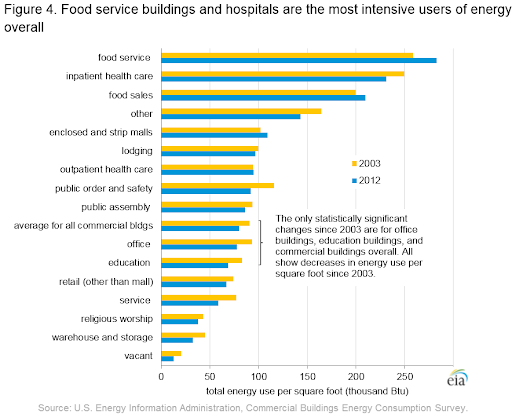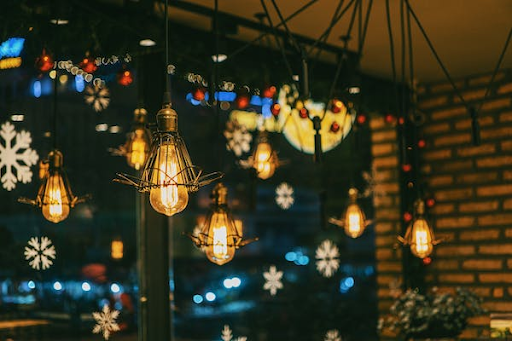
Restaurant Energy Consumption: Lowering Monthly Costs Is Easy
Utility bills are a huge part of anyone’s monthly budget. As a restaurant owner, you may have already noticed that energy accounts for 3-5% of your total operational costs. Fortunately, saving money and cutting back on energy are possible to do while meeting your business operation needs.This is part of effective restaurant energy management.
With a few tweaks to your daily routine and a little help from an energy efficiency partner, you can take charge of your energy bills. In this article, you will see where restaurants spend the most and what you can do to cut back.
How to Reduce Energy Consumption in a Restaurant
The average restaurant energy consumption rate is 5 to 7 times higher than any other type of commercial building. Even when looked at by industry, food service buildings top the charts.

Source: U.S. Energy Information Administration
Your restaurant may be wasting a lot of energy without you realizing it. The first step to optimizing your energy usage is knowing where your restaurant is using the most energy, then you can find ways to reduce it. Here are the ways a typical restaurant consumes energy and tips for how to cut yours down.
Heating and Cooling
An HVAC system is necessary to keep customers comfortable. However, if you’re in a building that does not have sufficient insulation, you’ll have to run your HVAC harder and for longer.
Additionally, your kitchen creates heat while you cook, meaning your air conditioner has to put in that much more effort to keep your premises cool.
As a result, in the restaurant industry, the energy consumption rate from HVAC systems is typically 25-30% of your entire energy bill.
What Can You Do?
Reduce energy consumption by upgrading your current HVAC system to a newer, high-efficiency model. Even HVACs that are just 10 years old can consume up to twice the energy as modern systems. Preventive maintenance, changing filters regularly, and installing programmable thermostats can help keep your HVAC energy consumption under control. Getting your insulation checked regularly will also help you get more from your HVAC system.
Staff training, often overlooked, can help save money too. For example, you may select a set temperature point for each season and encourage your staff to keep it there. Even little things like not leaving doors open can have a significant impact.
For HVACs that are over 10 years old, it may be time for an upgrade. Replacing the air conditioner and furnace can offer substantial energy savings immediately. (And you may be able to do it with zero upfront cost.)
Lighting
Here’s a staggering restaurant energy consumption statistic: lighting may account for 15-45% of a restaurant’s electricity bill. In regions that do not require significant heating or cooling, lighting is sometimes the biggest source of restaurant energy consumption.
Plus, traditional lighting wastes extra energy as heat which, you guessed it, has a negative impact on your HVAC.
What Can You Do?
If your restaurant is still using energy-intensive fluorescent or halogen light bulbs, it may be time to consider switching to a more energy-efficient light source, such as LED bulbs. LED lighting looks contemporary, too, and you can find lighting fixtures for any ambiance.
Whatever lights you use, staff policies go a long way. Encourage staff to turn off lights that aren’t in use. Regularly cleaning the dust off of your light fixtures will also discourage staff from turning dimmer switches up too high.
Restaurant electricity monitoring that lets you track how much electricity your lighting uses can be a good way to keep your staff accountable to your “lights off” policy.

Sanitation
Food-safe sanitation consumes a lot of water. Restaurant energy consumption statisticscollected by the Green Restaurant Association show that restaurants consume 300,000 gallons of water per year.
Additionally, you need hot water to kill germs and scrub sticky food off your dishes. The energy you consume heating your water tanks is also eating your budget.
What Can You Do?
An intelligent energy monitoring solution can track water consumption and heating. Temperature monitoring helps reduce your energy consumption by helping you keep your water tank at a stable temperature. You will even receive insights into off-peak electricity pricing, allowing you to schedule dishwashing for those times of the day.
Your serving staff can also cut back your water consumption. By only offering water to customers upon request you can save 2 gallons per glass; from both the drinking water and the water you would have used to wash the glasses.
Meal Preparation
Walk-in freezers, commercial ovens, and fryers are some of the biggest energy consumers in your kitchen. A typical commercial deep fat fryer uses 18,000 kWh (kilowatt-hours) per year; a startling statistic considering the average American household uses a total of 12,000 kWh.
Many customers enjoy their drinks with ice, and some recipes use ice as an ingredient. 2.5 million commercial buildings across the United States use an ice machine resulting in a combined electricity bill of $1.62 billion annually.
Older restaurant equipment also consumes significantly more energy than newer machines. In fact, PG&E suggests that energy waste caused by outdated food service equipment accounts for 80% of a restaurant’s energy consumption.
What Can You Do?
Monitoring the temperature of your freezers and refrigerators is a great start. Not only will you save money on your energy costs, but you will also reduce the cost of lost inventory by preventing food spoilage.
Internet of Things (IoT) sensors and advanced software monitor energy usage of a wide range of commercial kitchen appliances. They provide instant insight into whether the equipment is operating normally, if energy usage is higher than normal, and how you can reduce costs.
High-efficiency appliances can save hundreds of dollars every month, compared to older equipment, and pay for themselves. Yet they can come with a steep upfront cost. And that’s where an Energy Efficiency as a Service (EEaaS) partner can help.
|
Learn more: |
Reducing Energy Consumption in Your Restaurant Is Easy…
An EEaaS partner like Budderfly can make energy efficiency upgrades at your restaurant a reality. We take care of the upfront expense (and risk) of upgrading your current cooking, freezing, HVAC, and refrigeration systems to more energy-efficient equipment. We also take care of installation and equipment maintenance, meaning a hassle-free experience for you.
Our efficiency monitoring will help you track how much you save, and you’ll receive real-time insights into how you can reduce energy consumption still further.
Contact us to start saving money today.
.


